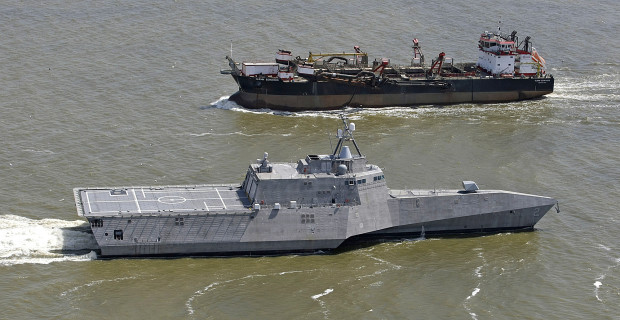Navy warships to trade some speed for firepower, armor

In this March 24, 2010, file photo, the littoral combat ship USS Independence, foreground, passes another vessel as it makes its way south through the waters of Mobile Bay, Alabama. The Navy spent hundreds of millions of taxpayer dollars to fulfill its need for speed with the fast and agile warships like the Independence. The gee-whiz factor of the ships, designed to meet unconventional threats and to operate in shallow coastal waters, has been overshadowed by concerns over costs and survivability during combat. GM ANDREWS / AL.com / AP
BATH, Maine, United States — The Navy spent hundreds of millions of taxpayer dollars to fulfill its need for speed with a new class of fast and agile warships capable of zipping along at highway speeds.
It turns out speed is overrated.
The Navy has learned lessons from the light-and-speedy littoral combat ships: Upcoming ships will trade some speed in favor of more weapons and heavier armor.
READ: US Navy’s newest warship breaks down, towed to port | Largest hi-tech US destroyer begins sea trial — Navy
Rear Adm. Peter Fanta, director of surface warfare, said the goal is to increase the offensive punch of all warships from the biggest to the smallest. For the littoral combat ship, that’ll begin with the installation of over-the-horizon missiles this summer.
Article continues after this advertisement“Each ship that I now have — I have to make more lethal because I cannot build ships fast enough, or enough of them,” Fanta told The Associated Press.
Article continues after this advertisementTwo versions of the warships were sped into production to meet the Navy’s goal of an affordable, fast ship to operate in shallow coastal — or littoral — waters.
The ships, which are capable of topping 50 mph, utilize steerable waterjets instead of propellers and rudders to operate in shallow water.
They also are built to be equipped with swappable mission modules for surface warfare, anti-submarine duty or mine removal. That’s in contrast to larger, multi-mission ships like the 610-foot Michael Monsoor, a Zumwalt-class destroyer christened Saturday at Bath Iron Works.
But the gee-whiz factor was overshadowed by concerns over growing costs — the latest versions cost $482 million to $563 million apiece — along with criticism by the General Accounting Office that the warships were too lightly armed and too lightly armored.
Two high-profile breakdowns, in December and January, raised additional questions about reliability: The USS Milwaukee had to be towed 40 miles to a naval base in Virginia, while the USS Fort Worth was sidelined in Singapore.
Fanta said the Navy is learning from the initial deployments and incorporating changes into a new version which will be called a frigate. The Navy also intends to zero in on one design either next year or the following year, leading to cost savings.
The Freedom class with a steel monohull is built in Marinette, Wisconsin, while the tri-hulled, aluminum Independence class is built in Mobile, Alabama.
Both were rushed into production to deal with unconventional post-Cold War threats including swarm boats and pirates. But the threats have changed again with China flexing its muscle in the South China Sea and Russia reasserting its naval presence.
Despite growing pains, Fanta sees the warships as being made more capable through heavier armor plating and shock mounting to make them sturdier, along with additional weapons.
The first over-the-horizon missile capable of hitting targets more than 50 miles away is to be installed this summer and it will be followed by tests of a second missile variant this fall, he said. Some of the capabilities will be fitted onto existing ships, about two dozen of which are either in the fleet, under construction or under contract. Eventually, the Navy plans to build 40 of them.
The resulting ship will be slightly slower and heavier, but the weapons will make enemies keep their distance, he said.
It’s unclear how much speed will be lost because of the added weight.
“We acknowledge that there will be trade-offs in speed based on additional weight to support increased capabilities. That number will be defined further as the ship’s design continues to mature,” said Ensign Marc Rockwellpate, a Navy spokesman.
Loren Thompson from the Lexington Institute said it makes sense to place less emphasis on speed. “You can’t outrun a missile,” he said.